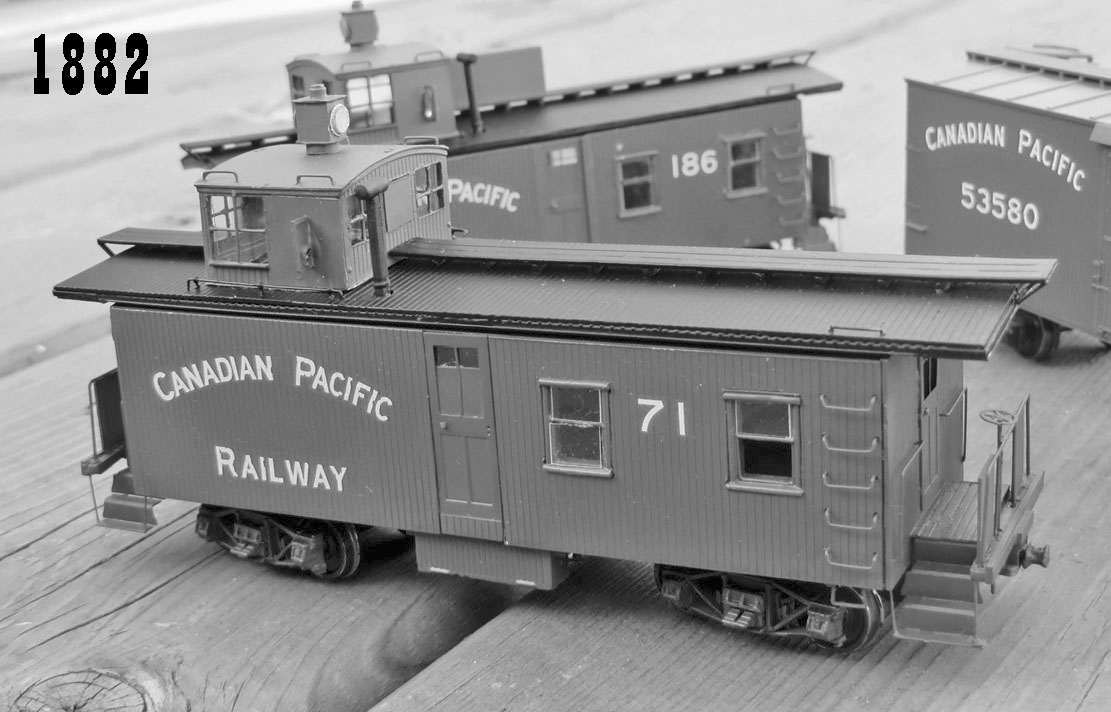Two early cabooses from Canadian Pacific's 1880s pioneer era
Oct 19, 2019 4:43:25 GMT -8
The Ferro Kid, onequiknova, and 10 more like this
Post by sd40dash2 on Oct 19, 2019 4:43:25 GMT -8
For some strange reason, I am seeing very little standard gauge mainline modelling being done from CPR's 1880-1900 pioneer or construction era. I decided to give it a try and see how far I could get before running into a roadblock. These models of CP 71 and 186 represent the early era of CP’s common CP 35’ 5” wood caboose design. Approximately 2000 cabooses of this general type (with numerous changes over time) were made from 1881 until 1948 and the last ones remained in service until 1990. Many of them still exist on public display today.
I used the Roundhouse (MDC) “Old Timer” caboose model as a starting point. The body, frame and roof were all shortened and re-sheathed with styrene of various shapes and sizes while numerous unneeded kit parts were placed in my surplus bin. Weights were shortened and mounted inside the shell for improved appearance instead of below the floor as designed by MDC. Only a few commercial parts were used – most of the work on this project was on styrene fabrication and wire cutting.

After many enjoyable modelling hours and some time in the paint booth, here is the final result. This distinctive arched lettering style was typical for late-19th century North American railway equipment. It was used on CP cabooses for over 30 years from 1881 until 1912 when it was replaced with the much-smaller block lettering. The MDC cupola is incorrect for CP, so a spare Kaslo cupola from a prior build was adapted to both models and heavily modified and detailed.


These road numbers were specifically chosen to pre-date train air brakes which did not appear en-masse until the mid-1890s. Truss rods were made from 6 lb. fishing line. Prototype trucks were the Double Diamond arch bar style that I was unable to source in HO, so I used Walthers Arch Bar caboose trucks instead. Couplers are the era-correct link and pin style, but grafted onto scrap Kadee-clone shanks and installed in the kit draft gear boxes. The boxes are not correct for these 1880s-era models but this allows for easy replacement with operational knuckle couplers (or new draft gear boxes) if desired in the future. The prototype requirement for knuckle style couplers was not fully implemented until 1900, some 15-20 years after the era represented by these models.

Thank you to Canadian Pacific Historical Association, Ray Breyer, Dave Love, George Toman and John Ott for providing technical assistance.
Questions, comments or requests for additional photos are most welcome. Thanks for your interest.
I used the Roundhouse (MDC) “Old Timer” caboose model as a starting point. The body, frame and roof were all shortened and re-sheathed with styrene of various shapes and sizes while numerous unneeded kit parts were placed in my surplus bin. Weights were shortened and mounted inside the shell for improved appearance instead of below the floor as designed by MDC. Only a few commercial parts were used – most of the work on this project was on styrene fabrication and wire cutting.

After many enjoyable modelling hours and some time in the paint booth, here is the final result. This distinctive arched lettering style was typical for late-19th century North American railway equipment. It was used on CP cabooses for over 30 years from 1881 until 1912 when it was replaced with the much-smaller block lettering. The MDC cupola is incorrect for CP, so a spare Kaslo cupola from a prior build was adapted to both models and heavily modified and detailed.


These road numbers were specifically chosen to pre-date train air brakes which did not appear en-masse until the mid-1890s. Truss rods were made from 6 lb. fishing line. Prototype trucks were the Double Diamond arch bar style that I was unable to source in HO, so I used Walthers Arch Bar caboose trucks instead. Couplers are the era-correct link and pin style, but grafted onto scrap Kadee-clone shanks and installed in the kit draft gear boxes. The boxes are not correct for these 1880s-era models but this allows for easy replacement with operational knuckle couplers (or new draft gear boxes) if desired in the future. The prototype requirement for knuckle style couplers was not fully implemented until 1900, some 15-20 years after the era represented by these models.

Thank you to Canadian Pacific Historical Association, Ray Breyer, Dave Love, George Toman and John Ott for providing technical assistance.
Questions, comments or requests for additional photos are most welcome. Thanks for your interest.





